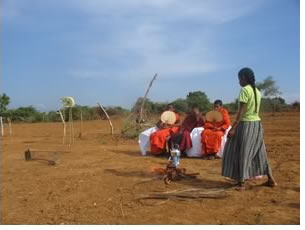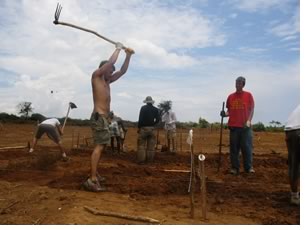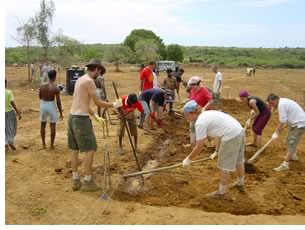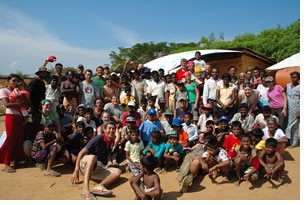

04/2005
Twenty-one Ball State University students returned March 20 from a two-week rebuilding project in a fishing village in southern Sri Lanka that had been devastated by last December’s tsunami. The students are part of a program called “CapAsia,” a 10-week field study program offered by the College of Architecture and Planning at Ball State that provides both graduate and undergraduate architecture students with experience in world architecture, urbanism, and planning.
(One week after the students and faculty returned home, another earthquake struck the region, but fortunately there wasn’t another tsunami.)
Building to learn
Ball State’s CapAsia’s motto is “building to learn.” It
refers to CapAsia’s theory that architecture students learn about
themselves and their craft by engaging the people and architecture of
other cultures. CapAsia students traveled to southern Sri Lanka to the
rural fishing village of Kalametiya, part of a coastal wetland system
along the south coast of Sri Lanka, where they rebuilt homes that were
completely destroyed by last December’s tsunami. The group altered
its original plan during its annual architecture field study trip to
go to Kalametiya to help with the rebuilding efforts.
 The small village is home to 31 families, including 30 children. The
village had a total of 190 people before the tsunami; 11 were killed.
After the tsunami, all were living in either tents or wooden beach cabanas
that were still standing. Debris and uprooted trees littered the village,
a lagoon, and a bird sanctuary. The Ball State students arrived in early
March to assist in the construction of permanent houses with local citizens,
masons, carpenters, and volunteers. The effort included restoring the
lagoon and bird sanctuary and repairing fishing boats.
The small village is home to 31 families, including 30 children. The
village had a total of 190 people before the tsunami; 11 were killed.
After the tsunami, all were living in either tents or wooden beach cabanas
that were still standing. Debris and uprooted trees littered the village,
a lagoon, and a bird sanctuary. The Ball State students arrived in early
March to assist in the construction of permanent houses with local citizens,
masons, carpenters, and volunteers. The effort included restoring the
lagoon and bird sanctuary and repairing fishing boats.
The layout of the rebuilt village consisted of 30 houses grouped in clusters and public facilities that included a community center, pre-school, library, and shrine. The landscaped common spaces were a village square, playground, memorial garden, and a forested area.
 The
rebuilding efforts saw students create all 30 single-story houses, each
in its own plot of 500 square meters (a little over 5,000 square feet),
with a foundation mixture of concrete and rubble. Each new house has
two bedrooms and a front and rear verandah, living room, kitchen, bath,
and toilet. The homes were made with burnt-clay-brick walls, cement floors,
clay-tile roofs on timber frameworks, timber-sashed doors, and windows
with stick-grills. With construction now complete, residents can celebrate Sinhala and
the Hindu New Year, April 13–14, in their new homes.
The
rebuilding efforts saw students create all 30 single-story houses, each
in its own plot of 500 square meters (a little over 5,000 square feet),
with a foundation mixture of concrete and rubble. Each new house has
two bedrooms and a front and rear verandah, living room, kitchen, bath,
and toilet. The homes were made with burnt-clay-brick walls, cement floors,
clay-tile roofs on timber frameworks, timber-sashed doors, and windows
with stick-grills. With construction now complete, residents can celebrate Sinhala and
the Hindu New Year, April 13–14, in their new homes.
Energizing a village
Dr. Nihal Perera, a Sri Lanka native, is the founder and director of
CapAsia. “It went very well,” he says. “The whole
point of this was to expose our students to a different culture of
building. The main question is: ‘Why do they build the way they
build’? We are trying to participate in their processes, rather
than getting them to participate in our processes.”
 Perera
explains that he and students became a catalyst for the villagers. “We
energized the people. We were able to connect with community there.” He
points out one big success was when his students built a small play area
for the children. “The children were highly neglected. Not purposefully
. . . their parents were involved in bigger things, trying to get a place
to stay. Our students used material from the debris to create a small
play area for the kids. We brought some paint and drawing paper, and
the students made paint brushes from peacock feathers. All of this was
pretty much improvised, but it worked very well. The kids started playing
and painting and the parents seemed very happy. Then our students started
playing volleyball with the younger ones, and then we played cricket
with all the children, which they all very much love to play. We all
bonded very much. Then, two days later, we started building and all the
villagers showed up. All of a sudden, the community came alive.”
Perera
explains that he and students became a catalyst for the villagers. “We
energized the people. We were able to connect with community there.” He
points out one big success was when his students built a small play area
for the children. “The children were highly neglected. Not purposefully
. . . their parents were involved in bigger things, trying to get a place
to stay. Our students used material from the debris to create a small
play area for the kids. We brought some paint and drawing paper, and
the students made paint brushes from peacock feathers. All of this was
pretty much improvised, but it worked very well. The kids started playing
and painting and the parents seemed very happy. Then our students started
playing volleyball with the younger ones, and then we played cricket
with all the children, which they all very much love to play. We all
bonded very much. Then, two days later, we started building and all the
villagers showed up. All of a sudden, the community came alive.”
Perera says that the original idea was to build a demonstration house. But after two or three days—as all 21 students, 3 faculty members, and masons started building, along with displaced and non-displaced locals—the villagers started digging their own foundations for their own homes. Says Perera, “We had to re-think: ‘Maybe it’s not a good idea just to build a demonstration house if everybody is interested in building. Why not put our energy into helping everybody?’ In a few days all the houses were being built.”
 Understanding the culture
Understanding the culture
Since 1999, CapAsia students have visited Nepal, Sri Lanka, India, Singapore,
Thailand, and Malaysia. Students work to rebuild sustainable homes
in these locations using local hand tools and no electricity. Among
the highlights have been a three-week “build-design-build” project
at the University of Moratuwa in Colombo, Sri Lanka, where students
constructed a pavilion made of scavenged wood materials, such as dismantled
wood packing crates, disassembled timber pallets, and hand-sawn tree
trunks. They also designed and constructed a “mud” pavilion
from a sand and cement mixture combined with rubble from demolished
campus buildings.
“This is a program that allows students to do projects that are also helpful to local experts,” says Perera. “We send students house to house. They get to stay in one place and understand the culture.”
Copyright 2005 The American Institute of Architects.
All rights reserved. Home Page ![]()
![]()
 |
||
|
|
||
